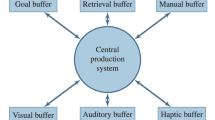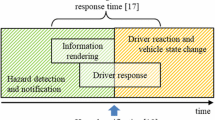Abstract
With the evolution of cars into complex electronic-mechanical systems and related increasing relevance of electronic manipulation and malicious attacks on automotive IT, Security warnings are becoming also more important. This paper presents the findings regarding the potential effect of IT security warnings in vehicles. Different warning approaches were designed and analyzed in driving simulator tests, based upon three representative IT security threats and three variations of the information quantity and recommended action. The potential effect of these warnings was measured using three scenarios, including the simulated consequences, e.g. sudden swerve of vehicle. We analyzed the implications on drivers reaction, task performance, thoughts and emotions to derive the stress level. We found a positive effect of given recommendations due to the lack of security awareness in automotive IT, accompanied by a high variety of warnings cause interpretations. Especially without given recommendation a higher rate of ignorance was observed, leading to accidents.
Access this chapter
Tax calculation will be finalised at checkout
Purchases are for personal use only
Similar content being viewed by others
Notes
- 1.
For the first test person the thermal video was lost due to an error discovered in the recording software.
References
Hoppe, T., Kiltz, S., Dittmann, J.: Security threats to automotive CAN networks – practical examples and selected short-term countermeasures. In: Harrison, M.D., Sujan, M.-A. (eds.) SAFECOMP 2008. LNCS, vol. 5219, pp. 235–248. Springer, Heidelberg (2008)
Hoppe, T., Kiltz, S., Dittmann, J.: Automotive IT-security as a challenge: basic attacks from the black box perspective on the example of privacy threats. In: Buth, B., Rabe, G., Seyfarth, T. (eds.) SAFECOMP 2009. LNCS, vol. 5775, pp. 145–158. Springer, Heidelberg (2009)
Koscher, K., Czeskis, A., Roesner, F., Patel, S., Kohno, T., Checkoway, S., McCoy, D., Kantor, B., Anderson, D., Shacham, H., Savage, S.: Experimental security analysis of a modern automobile. In: The IEEE Symposium on Security and Privacy, Oakland, CA, 16−19 May 2010
Miller, C, Valasek, C.: Adventures in automotive networks and control units. In: DEF CON 21 Hacking Conference, 1–4 August 2013, Las Vegas, USA (2013). http://illmatics.com/car_hacking.pdf. Accessed 20 January 2015
Larson, U.E., Nilsson, D.K., Jonsson, E.: An approach to specification-based attack detection for in-vehicle networks. In: Proceedings of the IEEE Intelligent Vehicles Symposium, Eindhoven, The Netherlands, 4–6 June 2008, pp. 830–835. IEEE Xplore, 978-1-424-42568-6 (2008)
Müter, M., Groll, A.: Attack detection for in-vehicle networks. In: 25. VDI/VW Gemeinschaftstagung – Automotive Security, Ingolstadt, Germany, 19. Oktober 2009. VDI Wissensforum, Verein Deutscher Ingenieure (VDI) (2009)
Hoppe, T., Kiltz, S., Dittmann, J.: Applying intrusion detection to automotive IT – early insights and remaining challenges. J. Inf. Assur. Secur. (JIAS) 4(3), 226–235 (2009)
Müter, M., Hoppe, T., Dittmann, J.: Decision model for automotive intrusion detection systems. In: Automotive - Safety & Security 2010, pp. 103−116. Shaker Verlag, Aachen (2010). ISBN 978-3-8322-9172-3
Han, I.S., Han, W.-S.: Application of biologically inspired visual information processing in affective driver status monitoring. In: The 24th International Technical Conference on the Enhanced Safety of Vehicles (ESV), Gothenburg, Sweden, 8–11 June 2015
Soleymani, M., Esfeden, S.A., Fu, Y., Pantic, M.: Analysis of EEG signals and facial expressions for continuous emotion detection, IEEE Transactions on Affective Computing, May 2015
Nielsen, J., Clemmensen, T., Yssing, C.: Getting access to what goes on in peoples heads? - Reflections on the think-aloud technique. In: Proceedings of the Second Nordic Conference on Human-Computer Interaction, pp. 101−110 (2002)
McDonald, S., Edwards, H.M., Zhao, T.: Exploring think alouds in usability testing: An international survey. IEEE Trans. Prof. Commun. 55, 2–19 (2012). cited on Page 55 and 56
OpenDS: Open Source Driving Simulator (2015). Project web site at http://www.opends.eu/
Kimberg, D.Y., Farah, M.J.: A unified account of cognitive impairments following frontal lobe damage: the role of working memory in complex, organized behavior. J. Exp. Psychol. Gen. 122(4), 411–428 (1993)
Acknowledgements
We thank our students in the team AUTOalert and EmotionTransition for supporting these research activities with their contributions in our Multimedia Systems Project lecture in winter term 2014/2015.
This work was partly (performing the tests and evaluation of the results, emotional aspects and resilience linked analysis) supported by German Research Foundation, project ORCHideas (DFG GZ: 863/4-1).
This work was also partly (definition of the scenarios derived from the high level project requirements) supported by European Research Foundation, project SAVELEC (Safe control of non cooperative vehicles through electromagnetic means, FP7- SEC-2011, Grant Agreement Number 285202).
Author information
Authors and Affiliations
Corresponding author
Editor information
Editors and Affiliations
Rights and permissions
Copyright information
© 2015 Springer International Publishing Switzerland
About this paper
Cite this paper
Altschaffel, R., Hoppe, T., Kuhlmann, S., Dittmann, J. (2015). Simulation of Automotive Security Threat Warnings to Analyze Driver Interpretations and Emotional Transitions. In: Koornneef, F., van Gulijk, C. (eds) Computer Safety, Reliability, and Security. SAFECOMP 2014. Lecture Notes in Computer Science(), vol 9337. Springer, Cham. https://doi.org/10.1007/978-3-319-24255-2_5
Download citation
DOI: https://doi.org/10.1007/978-3-319-24255-2_5
Published:
Publisher Name: Springer, Cham
Print ISBN: 978-3-319-24254-5
Online ISBN: 978-3-319-24255-2
eBook Packages: Computer ScienceComputer Science (R0)




